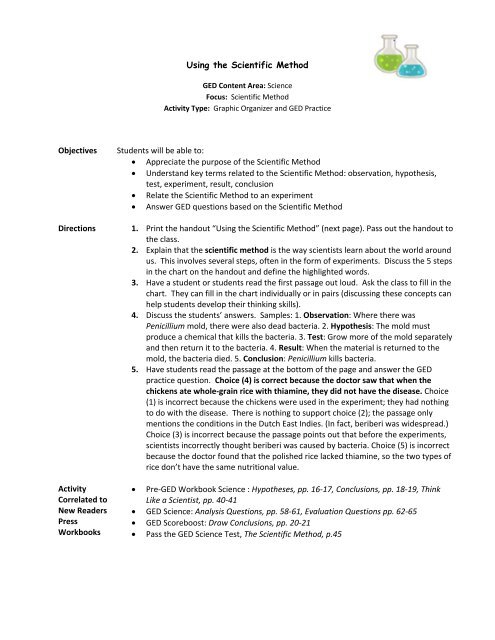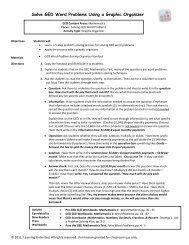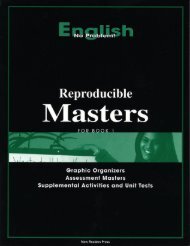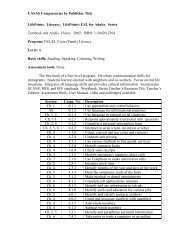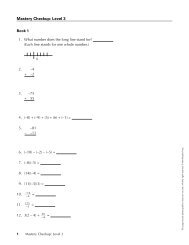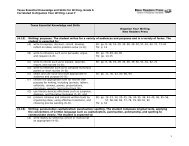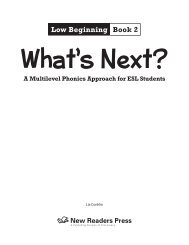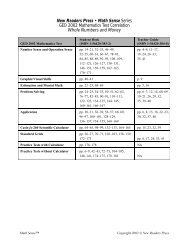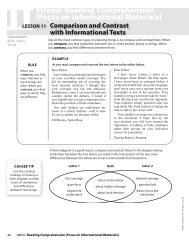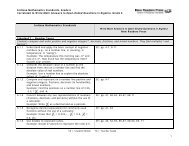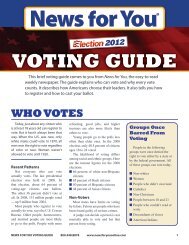Using the Scientific Method Objectives Students will be able to ...
Using the Scientific Method Objectives Students will be able to ...
Using the Scientific Method Objectives Students will be able to ...
You also want an ePaper? Increase the reach of your titles
YUMPU automatically turns print PDFs into web optimized ePapers that Google loves.
<strong>Using</strong> <strong>the</strong> <strong>Scientific</strong> <strong>Method</strong><br />
GED Content Area: Science<br />
Focus: <strong>Scientific</strong> <strong>Method</strong><br />
Activity Type: Graphic Organizer and GED Practice<br />
<strong>Objectives</strong><br />
Directions<br />
Activity<br />
Correlated <strong>to</strong><br />
New Readers<br />
Press<br />
Workbooks<br />
<strong>Students</strong> <strong>will</strong> <strong>be</strong> <strong>able</strong> <strong>to</strong>:<br />
Appreciate <strong>the</strong> purpose of <strong>the</strong> <strong>Scientific</strong> <strong>Method</strong><br />
Understand key terms related <strong>to</strong> <strong>the</strong> <strong>Scientific</strong> <strong>Method</strong>: observation, hypo<strong>the</strong>sis,<br />
test, experiment, result, conclusion<br />
Relate <strong>the</strong> <strong>Scientific</strong> <strong>Method</strong> <strong>to</strong> an experiment<br />
Answer GED questions based on <strong>the</strong> <strong>Scientific</strong> <strong>Method</strong><br />
1. Print <strong>the</strong> handout “<strong>Using</strong> <strong>the</strong> <strong>Scientific</strong> <strong>Method</strong>” (next page). Pass out <strong>the</strong> handout <strong>to</strong><br />
<strong>the</strong> class.<br />
2. Explain that <strong>the</strong> scientific method is <strong>the</strong> way scientists learn about <strong>the</strong> world around<br />
us. This involves several steps, often in <strong>the</strong> form of experiments. Discuss <strong>the</strong> 5 steps<br />
in <strong>the</strong> chart on <strong>the</strong> handout and define <strong>the</strong> highlighted words.<br />
3. Have a student or students read <strong>the</strong> first passage out loud. Ask <strong>the</strong> class <strong>to</strong> fill in <strong>the</strong><br />
chart. They can fill in <strong>the</strong> chart individually or in pairs (discussing <strong>the</strong>se concepts can<br />
help students develop <strong>the</strong>ir thinking skills).<br />
4. Discuss <strong>the</strong> students’ answers. Samples: 1. Observation: Where <strong>the</strong>re was<br />
Penicillium mold, <strong>the</strong>re were also dead bacteria. 2. Hypo<strong>the</strong>sis: The mold must<br />
produce a chemical that kills <strong>the</strong> bacteria. 3. Test: Grow more of <strong>the</strong> mold separately<br />
and <strong>the</strong>n return it <strong>to</strong> <strong>the</strong> bacteria. 4. Result: When <strong>the</strong> material is returned <strong>to</strong> <strong>the</strong><br />
mold, <strong>the</strong> bacteria died. 5. Conclusion: Penicillium kills bacteria.<br />
5. Have students read <strong>the</strong> passage at <strong>the</strong> bot<strong>to</strong>m of <strong>the</strong> page and answer <strong>the</strong> GED<br />
practice question. Choice (4) is correct <strong>be</strong>cause <strong>the</strong> doc<strong>to</strong>r saw that when <strong>the</strong><br />
chickens ate whole‐grain rice with thiamine, <strong>the</strong>y did not have <strong>the</strong> disease. Choice<br />
(1) is incorrect <strong>be</strong>cause <strong>the</strong> chickens were used in <strong>the</strong> experiment; <strong>the</strong>y had nothing<br />
<strong>to</strong> do with <strong>the</strong> disease. There is nothing <strong>to</strong> support choice (2); <strong>the</strong> passage only<br />
mentions <strong>the</strong> conditions in <strong>the</strong> Dutch East Indies. (In fact, <strong>be</strong>ri<strong>be</strong>ri was widespread.)<br />
Choice (3) is incorrect <strong>be</strong>cause <strong>the</strong> passage points out that <strong>be</strong>fore <strong>the</strong> experiments,<br />
scientists incorrectly thought <strong>be</strong>ri<strong>be</strong>ri was caused by bacteria. Choice (5) is incorrect<br />
<strong>be</strong>cause <strong>the</strong> doc<strong>to</strong>r found that <strong>the</strong> polished rice lacked thiamine, so <strong>the</strong> two types of<br />
rice don’t have <strong>the</strong> same nutritional value.<br />
Pre‐GED Workbook Science : Hypo<strong>the</strong>ses, pp. 16‐17, Conclusions, pp. 18‐19, Think<br />
Like a Scientist, pp. 40‐41<br />
GED Science: Analysis Questions, pp. 58‐61, Evaluation Questions pp. 62‐65<br />
GED Scoreboost: Draw Conclusions, pp. 20‐21<br />
Pass <strong>the</strong> GED Science Test, The <strong>Scientific</strong> <strong>Method</strong>, p.45
<strong>Using</strong> <strong>the</strong> <strong>Scientific</strong> <strong>Method</strong><br />
1. Read <strong>the</strong> passage and fill in <strong>the</strong> <strong>Scientific</strong> <strong>Method</strong> chart.<br />
How Penicillin Was Discovered<br />
In 1928, Sir Alexander Fleming was studying Staphylococcus bacteria growing in culture dishes. He<br />
noticed that a mold called Penicillium was also growing in some of <strong>the</strong> dishes. A clear area existed<br />
around <strong>the</strong> mold <strong>be</strong>cause all <strong>the</strong> bacteria that had grown in this area had died. In <strong>the</strong> culture dishes<br />
without <strong>the</strong> mold, no clear areas were present.<br />
Fleming hypo<strong>the</strong>sized that <strong>the</strong> mold must <strong>be</strong> producing a chemical that killed <strong>the</strong> bacteria. He decided <strong>to</strong><br />
isolate this substance and test it <strong>to</strong> see if it would kill bacteria. Fleming transferred <strong>the</strong> mold <strong>to</strong> a nutrient<br />
broth solution. This solution contained all <strong>the</strong> materials <strong>the</strong> mold needed <strong>to</strong> grow. After <strong>the</strong> mold grew, he<br />
removed it from <strong>the</strong> nutrient broth. Fleming <strong>the</strong>n added <strong>the</strong> nutrient broth in which <strong>the</strong> mold had grown <strong>to</strong><br />
a culture of bacteria. He observed that <strong>the</strong> bacteria died.<br />
1. What was <strong>the</strong> observation?<br />
2. What was <strong>the</strong> hypo<strong>the</strong>sis?<br />
3. How was <strong>the</strong> hypo<strong>the</strong>sis tested?<br />
4. What was <strong>the</strong> result of <strong>the</strong> experiment?<br />
5. What conclusion could <strong>be</strong> drawn?<br />
2. Answer <strong>the</strong> GED‐type question based on <strong>the</strong> <strong>Scientific</strong> <strong>Method</strong>.<br />
In 1887 a strange nerve disease attacked <strong>the</strong> people in <strong>the</strong><br />
Dutch East Indies. The disease was <strong>be</strong>ri<strong>be</strong>ri. Symp<strong>to</strong>ms of<br />
<strong>the</strong> disease included weakness and loss of appetite; victims<br />
often died of heart failure. Scientists thought <strong>the</strong> disease<br />
might <strong>be</strong> caused by bacteria. They injected chickens with<br />
bacteria from <strong>the</strong> blood of patients with <strong>be</strong>ri<strong>be</strong>ri. The<br />
injected chickens <strong>be</strong>came sick. However, so did a group of<br />
chickens that were not injected with bacteria.<br />
One of <strong>the</strong> scientists, Dr. Eijkman, noticed something.<br />
Before <strong>the</strong> experiment, all <strong>the</strong> chickens had eaten wholegrain<br />
rice, but during <strong>the</strong> experiment, <strong>the</strong> chickens were<br />
fed polished rice. Dr. Eijkman researched this interesting<br />
case. he found that polished rice lacked thiamine, a vitamin<br />
necessary for good health.<br />
Which of <strong>the</strong> following conclusions is based on <strong>the</strong><br />
experiment descri<strong>be</strong>d in <strong>the</strong> passage?<br />
(1) Humans can catch <strong>be</strong>ri<strong>be</strong>ri from diseased<br />
chickens.<br />
(2) Beri<strong>be</strong>ri only occurs in <strong>the</strong> Dutch East Indies.<br />
(3) Scientists have not yet determined which<br />
bacteria cause <strong>be</strong>ri<strong>be</strong>ri.<br />
(4) Adequate intake of thiamine prevents <strong>be</strong>ri<strong>be</strong>ri<br />
disease.<br />
(5) Whole grain rice and polished rice have<br />
equivalent nutritional value.<br />
Reading Selections: http://www.biologycorner.com/worksheets/scientificmethods<strong>to</strong>ries.html This work is<br />
licensed under a Creative Commons Attribution-NonCommercial-ShareAlike 3.0 United States License.


